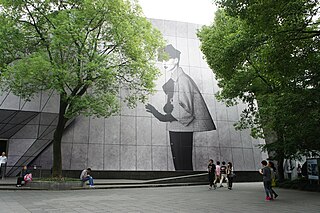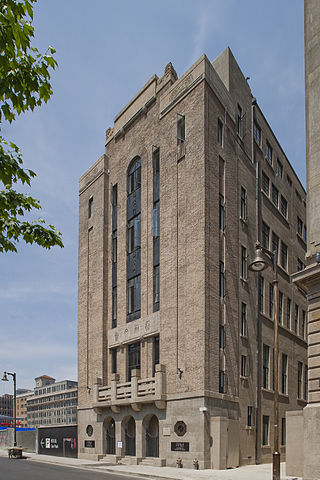
Shanghai is one of the four direct-administered municipalities of the People's Republic of China (PRC). The city is located on the southern estuary of the Yangtze River, with the Huangpu River flowing through it. The population of the city proper is the third greatest in the world, with 24.89 million inhabitants in 2021, while the urban area is the most populous in China, with 39.3 million residents. As of 2018, the Greater Shanghai metropolitan area was estimated to produce a gross metropolitan product (nominal) of nearly 9.1 trillion RMB. Shanghai is one of the world's major centers for finance, business and economics, research, science and technology, manufacturing, transportation, tourism, and culture, and the Port of Shanghai is the world's busiest container port.

The Shanghai Museum is a municipal public museum of ancient Chinese art, situated on the People's Square in the Huangpu District of Shanghai, China. It is funded by the Shanghai Municipal Culture and Tourism Bureau.

Jiading is a suburban district of Shanghai. It had a population of 1,471,100 in 2010.
Museum of Contemporary Art may refer to:

The Shanghai Art Museum was an art museum in the city of Shanghai, China. In October 2012, the museum was rebranded as the China Art Museum when it moved to the China pavilion at Expo 2010 on the former Shanghai Expo 2010 lands. The Shanghai Art Museum building is the former clubhouse building of the Shanghai Race Club. It sits on the western edge of People's Park, north of People's Square, which was once the Shanghai race course. The Shanghai Art Museum was the original home of the Shanghai Biennale, founded in 1996 by Fang Zengxian, then director of the museum. The former museum building is being converted to house the Shanghai History Museum, which had been left without a home due to redevelopment since 1999.

Lianhuanhua is a type of palm-size picture books of sequential drawings popular in China in the 20th century. It influenced modern manhua.

Zhang Xiaogang is a contemporary Chinese symbolist and surrealist painter. Paintings in his Bloodline series are predominantly monochromatic, stylized portraits of Chinese people, usually with large, dark-pupiled eyes, posed in a stiff manner deliberately reminiscent of family portraits from the 1950s and 1960s. Recently, he also created sculptures, translating for the first time into three dimensions many characters of the sort seen in his "Bloodlines—Big Family" portrait series. These sculptures have featured in many exhibits and continue his work as one of China's leading, and most highly sought-after, contemporary artists.

Shanghai North railway station, located on East Tianmu Road, was the main railway station of Shanghai during most of the 20th century. It was closed in 1987 and a replica of the original 1909 building, erected on the same site, is now the Shanghai Railway Museum. The station tracks are still in use as a coach yard. It was also known as the "沪宁铁路上海车站" referring to the Shanghai–Nanjing Railway, of which it was one terminal.
The Propaganda Poster Art Centre is a museum located in Shanghai which exhibits posters from the Maoist period of communist China, especially from the Cultural Revolution period. The museum was located in the basement of an apartment building in Huashan Road facing Wukang Road, in the former French Concession area until 2019 when it relocated to an office building on Yan'an West Road. It has a rich collection of rare last-piece posters.

50 Moganshan Road or "M50" is a contemporary art district in Shanghai, China, that houses a community of more than a hundred artists whose studios are open to the public. It is often compared with New York's SoHo and Beijing's 798 Art Zone. The art quarter has become a popular cultural attraction for local and international visitors alike, and was named among the top ten things to do in Shanghai by Time Magazine.

The Museum of Contemporary Art Shanghai is a contemporary art museum in the city of Shanghai, China. It is located within People's Park, north of People's Square, the location of a former racecourse that now holds the central administrative building and museums of Shanghai. Surrounding buildings include the Municipal Government Headquarters, the Shanghai Grand Theatre, the Shanghai Art Museum and the Shanghai Museum.

China Art Museum, Shanghai is a municipal art museum of Shanghai City. It is a public welfare institution funded by the Shanghai City Culture and Tourism Bureau.
The following is a timeline of the history of the city of Shanghai in China.

The Rockbund Art Museum is a contemporary art museum in central Shanghai. The museum is on Huqiu Road, in the former Royal Asiatic Society building completed in 1933 near The Bund waterfront. The museum is dedicated to being an influential, innovative, sustainable organization devoted to the promotion of projects within the field of international contemporary art. There are no permanent collections. Featured Chinese artists have included Cai Guo-Qiang and Zeng Fanzhi.

People's Park is a public park in Huangpu District of central Shanghai. It is located south of Nanjing Road, a major shopping street, and north of People's Square. Originally the northern part of the Shanghai Race Club's race course, the park was created in 1952. With several major museums and Shanghai's main shopping street nearby, it is one of the top tourist destinations in the city.
Xie Zhiliu was a leading traditional painter, calligrapher, and art connoisseur of modern China. He was a noted member of the Shanghai School of art. Xie and his wife Chen Peiqiu are one of the most famous couples in Chinese art. The government of Shanghai has opened a museum in Nanhui New City dedicated to them.

The Long Museum is a private art museum in Shanghai, China, founded by Liu Yiqian and his wife Wang Wei. The museum has two locations in Shanghai: the Long Museum Pudong and Long Museum West Bund.
Chen Ke is a Chinese artist. She currently lives and works in Beijing. Having participated in numerous international and domestic exhibitions, Chen Ke has worked in a variety of media, including painting, sculpture and fashion design. Chen Ke is recognized as the most representative artist of the New Generation of Cartoon of China.
The culture of Shanghai or Shanghainese culture is based on the Wuyue culture from the nearby Jiangsu and Zhejiang province, with a unique "East Meets West" Haipai culture generated through the influx of Western influences since the mid-19th century. Mass migration from all across China and the rest of the world has made Shanghai a melting pot of different cultures. It was in Shanghai, for example, that the first motor car was driven and (technically) the first train tracks and modern sewers were laid. It was also the intellectual battleground between socialist writers who concentrated on critical realism, which was pioneered by Lu Xun, Mao Dun, Nien Cheng and the famous French novel by André Malraux, Man's Fate, and the more "bourgeois", more romantic and aesthetically inclined writers, such as Shi Zhecun, Shao Xunmei, Ye Lingfeng and Eileen Chang.












